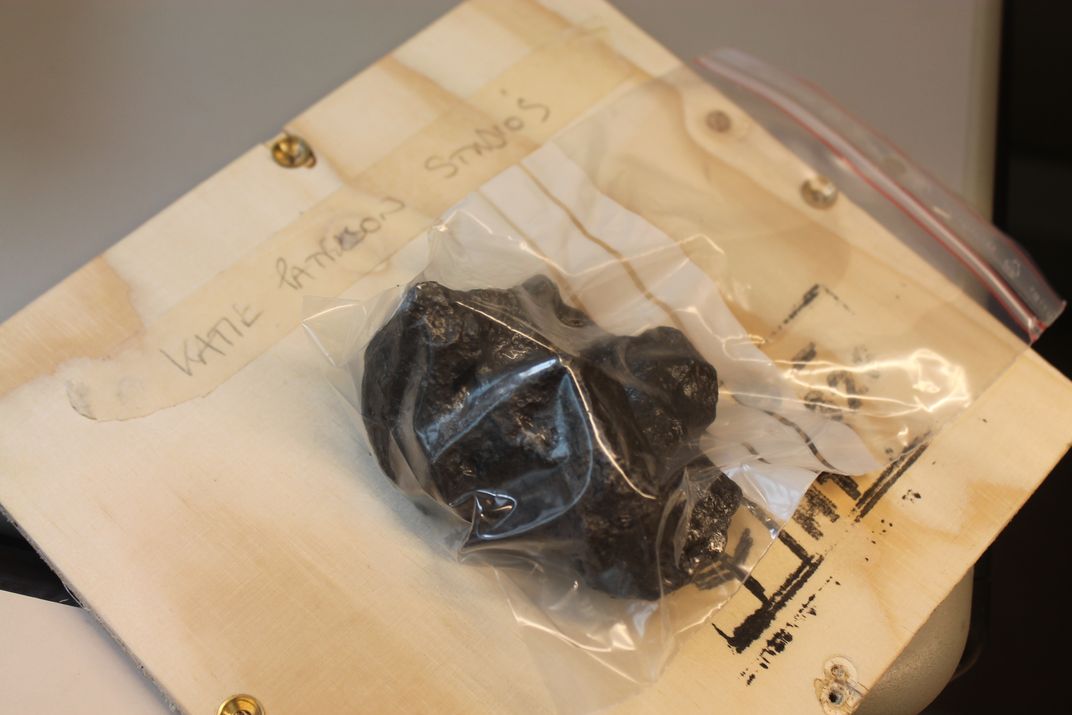A Meteorite Returns to Space, In the Name of Art
Artist Katie Paterson discusses bouncing sonatas off the moon, mapping dead stars, and her recent collaboration with the European Space Agency.
:focal(2433x962:2434x963)/https://tf-cmsv2-smithsonianmag-media.s3.amazonaws.com/filer/47/cc/47cc6faf-f609-4d7a-8351-7b2d04935445/katie_paterson_2012_3.jpg)
At around 12:20 Greenwich Mean Time on February 27, 2015, a meteorite will fall to Earth—for the second time. We wouldn’t usually know the time so specifically, except this time it’s coming down aboard the European Space Agency’s cargo vehicle, Georges Lemaître, the same way it got up to orbit last July.
The meteorite re-flight is the work of artist Katie Paterson, who melted down a meteorite found in Argentina, re-formed it into the same shape, and worked with ESA to give it a second ride back through Earth’s atmosphere. Paterson, born in Glasgow, Scotland, has shown her conceptual art about space and time all over the world; one can find her work in several collections, including the Guggenheim in New York. Paterson spoke to Air & Space Departments Editor Heather Goss about the meteorite, her astronomy research, and writing condolence letters for dead stars.
Air & Space: How does this second journey for the meteorite compare to its first?
Paterson: I came up with the idea for Campo del Cielo, Field of the Sky walking on the fairly barren Baltic coast. I was imagining objects falling from the sky, cosmic dust, asteroids, meteorites. Imagining the layers of time and existence, built up atom by atom inside the stone and metal, carried across from a time before earth existed. I put a meteorite through a man-made process, intricate and elemental, almost mimicking the cosmic melting that may have brought it into existence in the first place, the alchemical process that goes on all around us. Collapsing a sense of cosmic and human time.
The next stage of Campo del Cielo, Field of the Sky was to send the meteorite back into space. Remarkably, this happened last year [thanks to] the European Space Agency. A hand-sized, re-formed meteorite was launched on the Automated Transfer Vehicle, Georges Lemaître, which carried the cargo to the astronauts aboard the International Space Station. I never thought this idea would go beyond the dreaming stage. The meteorite will fall back to Earth [tucked into a trash bag] inside the ATV [on February 27], burning through the atmosphere upon reentry, in yet another cyclical process. We can only imagine what might happen next. Perhaps the grains of metal will be discovered again on a desert expanse, or dissolved into the sea.
We interviewed a scientist recently who is learning about how our solar system formed by studying the magnetic formations inside one of the oldest meteorites. If the insides of meteorites can tell us about the universe, what was your intention in melting your meteorite down and reforming it to be an identical shape?
That’s fascinating. I did a lot of research into which kind of meteorite to use in my work, I didn’t want be altering something that’s too precious or rare, or has specific scientific value. I decided to use a Campo del Cielo meteorite, which is the name the place it fell to in Argentina. It was an extremely large meteor shower, a huge amount of material fell to earth, over 100 tons. It broke up entering the atmosphere and shattered to earth. Some Campo del Cielo meteorites weigh so much they can’t even be moved.
Working with meteorite material was completely new to me. Their cosmic history is something that interests me a lot, the deep layers of time engrained within them, and the mystery of where they’ve come from. When we see and touch this ancient object—how does that make us feel and how do we experience and relate to it in terms of its ancient history?
The former NASA Astronaut Stan Love had this to say about the meteorite, which describes the intention beautifully. “Your project to send a meteorite to the ISS sounds interesting. I think the value is much more symbolic than scientific, especially if the sample you’re sending has been melted and re-cast. That process resets the ‘clock’ for geological age-dating techniques and erases the very interesting crystal patterns seen in ancient iron meteorites. The only words I’d add might be that we have taken an object that came to Earth from space, put a uniquely human signature on it, and returned it to space. On the most fundamental level, it’s a way of communicating with the universe.”
I first discovered your work by stumbling onto Earth-Moon-Earth (Moonlight Sonata Reflected from the Surface of the Moon). In space storytelling, there’s no greater tool than the environment’s inherent silence, much like the gaps in the moon-reflected version of the sonata. Do you feel that the resulting song tells a story about space? [Click the link to listen.]
The score has been on a journey. Perhaps you can hear its story in its absences. For me, sending the Moonlight Sonata to the moon was a way to try to connect with the moon, though it sent the score back in pieces. I can’t pinpoint exactly where the artwork lies here: Was it in the moon transmission? Or the sound heard afterwards in the gallery? Are the ‘missing notes’ still there, floating around on the moon, or in outer space? I think all of these elements are the artwork, it’s a dynamic process.
How did you first became interested in the ideas of space and time?
I’d say my first encounter with thinking about the vastness of space and the cosmos was in Iceland, where I lived for a while after I graduated from art school. Being in Iceland adjusted my view of the world, and later, the universe. I was overwhelmed by the scale of the sky and the changing light, the energy of the landscape. The earth underfoot is warm and exploding with life. I experienced the deepest silences, the vastest skies (watching the midnight sun set and rise in the same moment), the immensity of changing light and weather, monochromatic landscapes, and otherworldly nature. It was the first vivid experience I’ve had of being on a planet revolving [around] a sun. I started to look into space. I began to reflect more and more about our connections to the planet and the cosmos at large. As human beings we are not apart from nature, we are nature – we are made of atoms like everything else. It’s very easy to forget this.
Can you describe some of the astronomy-based research you’ve done for your artworks?
I’ve undertaken a lot of varied research with each project I’ve made, which have involved collaborations within science and technology. I’ve been lucky enough to track down people with great expertise who have engaged with my ideas, and who have had the generosity to devote a lot of time and energy to seeing them through. I worked with a physicist and engineer at OSRAM [German-based lighting manufacturer] to create light bulbs that simulate moonlight; with genetic evolutionists from the Sanger Institute in Cambridge, UK, to create a necklace made of carved fossils that charts Earth’s evolution through geological time. I’ve worked with radio hobbyists to reflect Beethoven’s Moonlight Sonata from the moon; and ‘supernova hunters’ and cosmologists to map dead stars. The relationships that are built up and the conversations that arise are an enriching part of the work for me.
Within astronomy I collaborated with Professor Ofer Lahav [at University College London] and his department to create a map of every dead star in the universe that has been witnessed or imaged by humankind. I also invited him to give an outdoor evening lecture on the death of stars, pointing out their absence in the sky. For Second Moon, I worked with mathematicians. Most recently, Timepieces (Solar System) was created with support from Professor Ian Robson, Royal Observatory, Edinburgh, and Dr. Stephen Fossey, University of London Observatory. This involved research into a range of subjects; horology, astronomical clocks, planetary orbits, solar days.
In The Dying Star Letters I posted a letter every time a star died, to declare its death. They were very simply written, “Dear XX, I’m sorry to inform you of the death of the star, GRB 2013b,” written on a variety of letter paper and posted from wherever I happened to be. I received the info via an electronic telegram directly from the telescopes, which turn themselves toward the bright explosions in the sky. I would pick up my pen and write. Sometimes the letter writing was a very ordinary experience, a task like doing the dishes, and other times it could be more deeply affecting, when I imagined the impact of this great stellar explosion which may have led to the existence of other planets and life.
What are some of the more interesting interactions you’ve had with these scientists? Did one describe a concept that blew you away? Or maybe someone just didn’t understand what you were trying to do with the information?
I was artist-in-residence in University College London’s Department of Physics and Astronomy, which allowed me to sit in on seminars and lectures and join in debates with the group. I was absorbed in so many subjects ranging from the Sagittarian Stream to the earliest objects in the universe. I kept returning to the idea of dying stars. The more I learn about their life and death cycles, and our intimate connection to these long-gone events, my fascination deepens. Our planet is a tiny speck on the outskirts of a galaxy, one of many millions of others, in an infinite universe that is expanding away. I’m interested in ways to conceive and relate to ideas like this; to that which cannot be easily seen or known.
One of the most extraordinary experiences I’ve had was accompanying the distinguished astronomer Professor Richard Ellis to the W.M. Keck Observatory, Hawaii, a remote outpost on the summit of Mauna Kea volcano. Astronomers there are studying the earliest galaxies, searching for the moment the stars “switched on.” I was particularly fascinated by a period called the Dark Ages, before the stars lit up, which I find rich with possibilities.
The sky above Keck is like nothing I’ve seen before, I can’t even begin to describe the stars. We were looking back in time 13.2 billions years, to the first stars to have evolved in the universe. Mauna Kea rises nearly 14,000 feet into the sky. Hawaiians call it Mauna Kea Kuahiwi Ku ha’o ika malie – “the astonishing mountain that stands in the calm.” Its summit is said to be the point where sky and earth pulled apart to create the vast expanse of space.
I took breaks to stand outside under the night sky. I was astonished that the light that we were measuring had travelled to reach earth and the Keck telescopes for about 90 percent of the life of the universe. We were actually observing the edge of the universe, and witnessing starlight that had traveled for millions of years. Many ideas for artworks stemmed from being at Keck, where the immensity of the universe came to the fore, experienced directly. We were witnessing an astonishingly vast area of the universe, appearing to us as a tiny fragment.
Do any of the scientists have reactions to your resulting artworks?
Professor Lahav has said that working together has allowed him to see his own subject through different eyes, and engaged their group in a different perspective on their work. We worked together on All the Dead Stars. I began this project by imagining what a dying star sounds like. I tracked down the sound, it is something like a middle C, and lasts a split second. This led to contemplating more about collapsing stars. I thought of mapping all of them, but had no idea if there were five or five million in the universe. So I wrote to 100 or so different astronomers, astrophysicists, and supernovae hunters from all over the world, asking them questions like ‘what is a dead star?’ ‘how many are there?’ ‘does a map like this exist already?’ etc. Lots of help later, after many conversations and finding masses of data on the internet, I catalogued and then plotted just under 27,000 supernovae, white dwarfs, gamma ray bursts, and other types of what can be considered ‘dead stars’ - all that have been recorded and observed by humans since the beginning of time. The map has been laser etched onto black anodized aluminum, 3 by 2 meters. In fact, 27,000 is only a fraction of what really exists, as one astronomer pointed out ‘You have gathered a representative set of stellar corpses. The list will forever be very incomplete. If it were complete your sculpture would need to be as big as the Earth. There are 100 billion stars in our one galaxy and a good fraction have died, and there are billions of galaxies.’
People are usually fascinated by the scale of the universe because its vastness seems impossible to fully grasp, which can either make one feel exceptional (that the ability to think about the universe at all is a gift) or terribly insignificant. Which do you feel? How does it affect the way you approach your artwork?
Contemplating the universe for me has the opposite affect of feeling insignificant. I can experience incomprehension in the face of sublime vastness, but I tend to feel an immense gratitude to have been born into something so astounding, so complex and vast. To be knitted together, intimately connected with it, rather than standing outside it. In my work I’m interested in the unseen connections that bind everything that exists together.
I was astonished to learn that all the matter that exists now in the universe is all that will ever exist, because everything - all the stars, galaxies and matter - is moving away from each other so quickly, it can no longer collide and produce new objects. For me, these are ideas that just can’t be rationalized, I think that’s why I’m drawn to art as a way to reflect about and convey these ineffable things.
Where do you get the images for History of Darkness? Why do this for a lifetime?
In History of Darkness I collect images of fields of darkness throughout the universe, make slides, and handwrite on the front their distance from earth in light years. The images are collected from telescopes all over the globe. The distances range from thousands to billions of light years away. Looking into these dark spaces, like oceans, perhaps we can imagine what has manifested there since – perhaps whole galaxies. Darkness exists everywhere and nowhere. It is latent with the past but also the future and all things.
Creating an ongoing series of black slides is a never-ending and absurd task, a futile one.
I’ve now catalogued around 8,000 or so slides of darkness. This is truly an ongoing artwork. The only end I can foresee is the decline in the production and development of slides. There is certainly an endless amount of darkness to continue on and on. I don’t find the scale of making the artwork daunting. When I first imagined the piece I saw that it had no end and accepted that fairly quickly. I work on History of Darkness in fits and starts.
The processes in all my works have different timespans, the almost instantaneous moment of forming ideas, and the collaborations and research stages, the material and production stages, which can span anything from one day to several years. Works like History of Darkness will go on throughout my lifetime. Within these durations are the time scales embedded inside the works themselves – millions of years of travelling light, billions of years of near-static darkness, ancient desert sands, the first signs of life strung on a necklace.
In a video where you speak with astronomy professor Ofer Lahav about All the Dead Stars, he says that “the boundaries between life and death are a bit fuzzy here…the end of one object might be really the beginning of another,” like a star that “dies” and becomes a black hole. Did you incorporate that idea at all in All the Dead Stars, or perhaps in another artwork?
The fuzziness between life and death runs through several artworks. Fossil Necklace charts the evolution of life on earth through carved fossils – trees, rocks, creatures, coal, coral, even fossilised rain. On the surface Fossil Necklace might look like a discrete and aesthetic object, but when probed further its dark side is revealed, the death and mass extinction of life repeatedly. The History of Darkness images are uprooted, they refer to places/times/spaces that could be anything and anywhere, with no definite beginning or end. Future Library is an artwork which will outlive me and the great majority of us alive today.
For Light Bulb to Simulate Moonlight I produced moonlight bulbs in sets of ‘lifetimes’ - 289 bulbs in each, 578,000 hours of moonlight, which is the average lifespan of a human being. A different number is inscribed into each bulb, and I supply a logbook with each set. The owner is asked to record the date each bulb is turned on, and the date it ends its life. All the bulbs could be burned together at once, or one by one, or never. So the owner enters into an ongoing engagement with the work. I like the idea of reclaiming the dead moonlight shells afterwards.
I hope it’s not strange to say that I found The Dying Star Letters to be delightfully morbid. Who do you fantasize as the recipient of such a condolence letter?
Professor Richard Ellis [of Caltech] was one of the recipients of the Dying Star Letters, which I felt appropriate. I’d quite like to send them out randomly. What a surprise to receive a letter like this instead of the monthly gas bill…
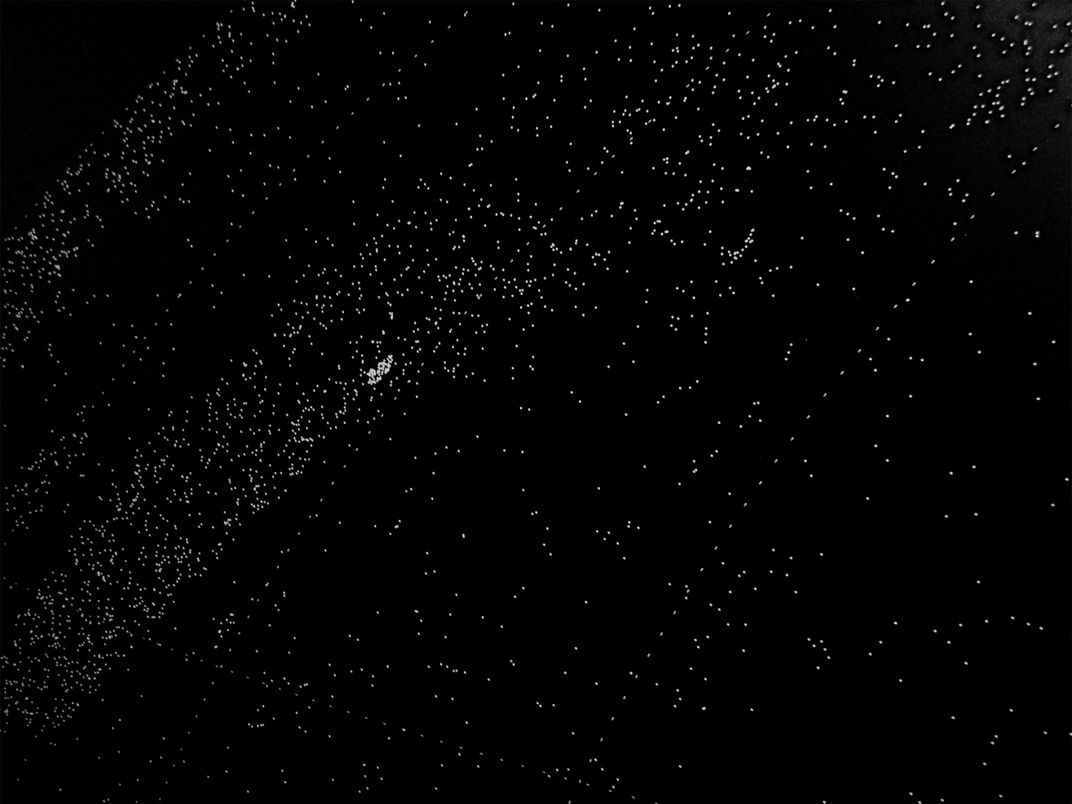
/https://tf-cmsv2-smithsonianmag-media.s3.amazonaws.com/filer/c0/ef/c0ef618b-793c-4087-af29-71d5a5de0e9e/katie_paterson_campo_del_cielo_field_of_the_sky_gp_120711_6695.jpg)
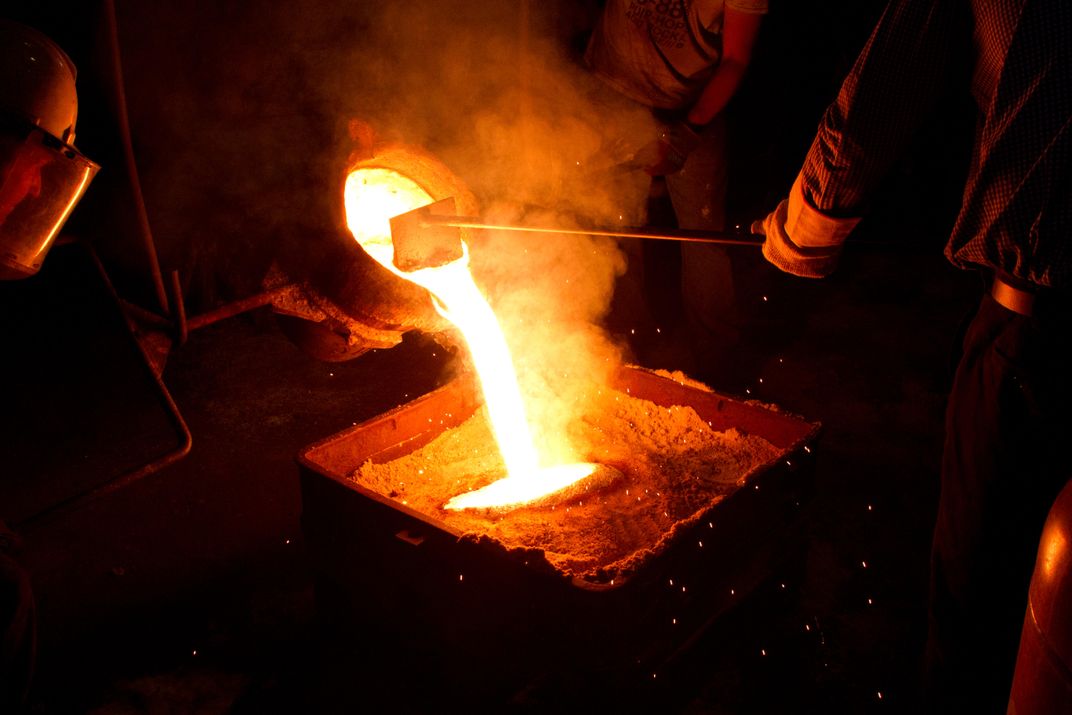
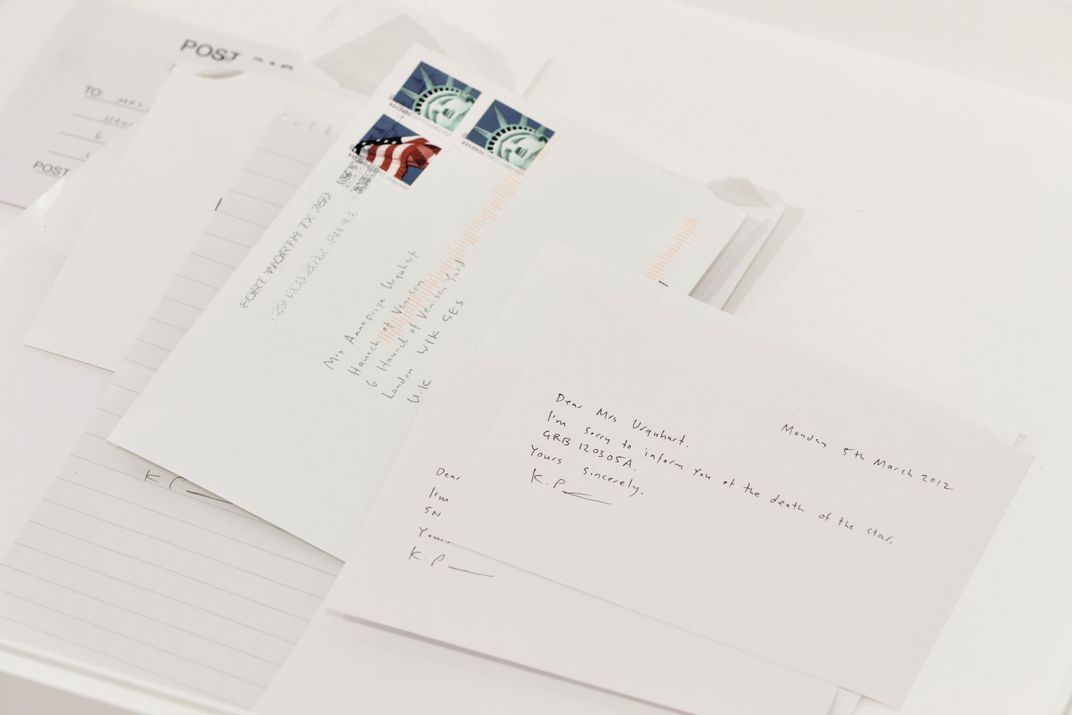
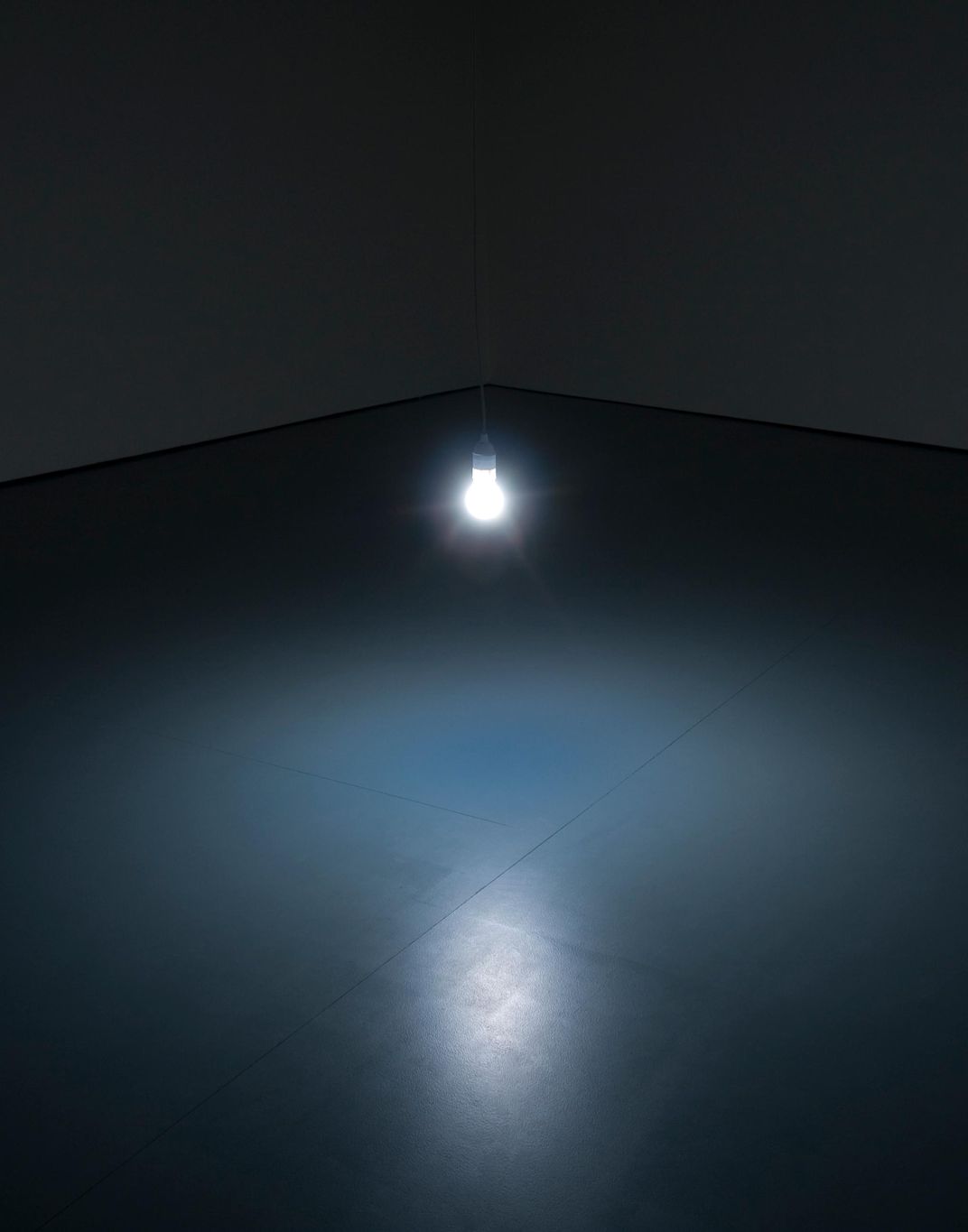
/https://tf-cmsv2-smithsonianmag-media.s3.amazonaws.com/filer/77/b6/77b6bfd2-9799-46af-8c80-af1b75481969/kp_last_atv_liftoff1.jpg)

